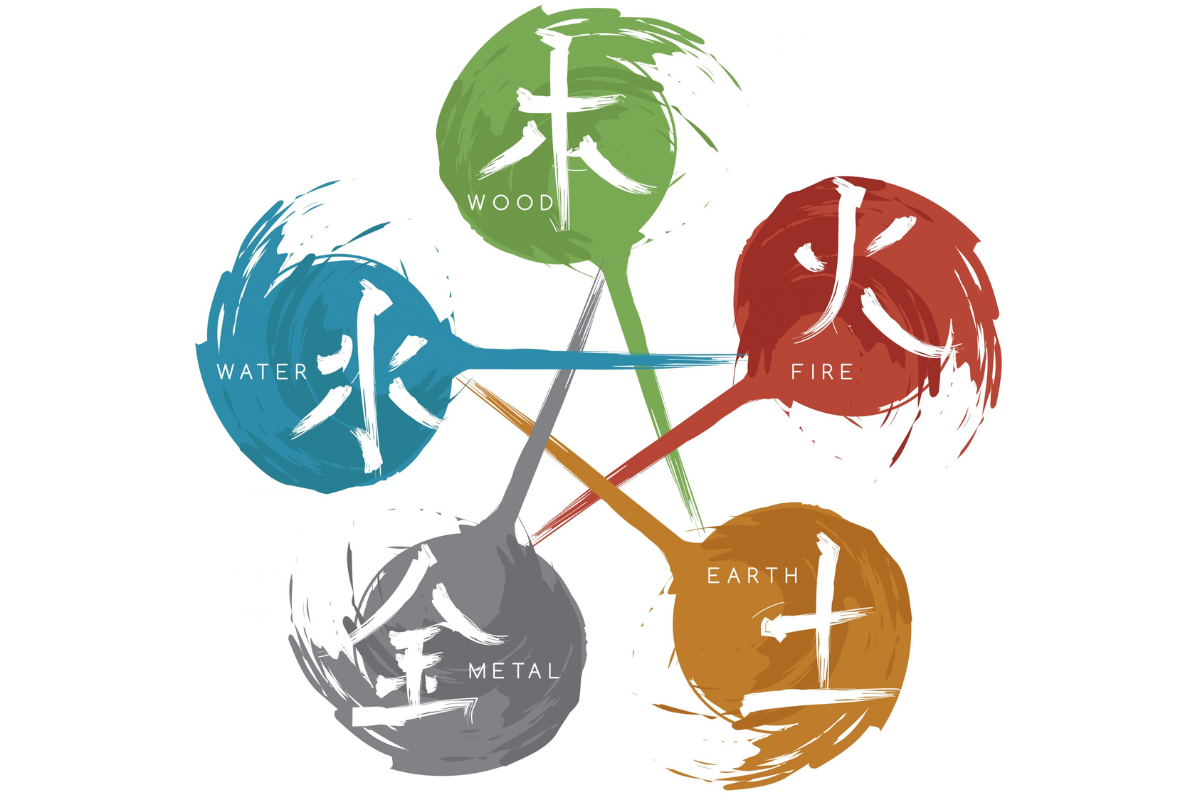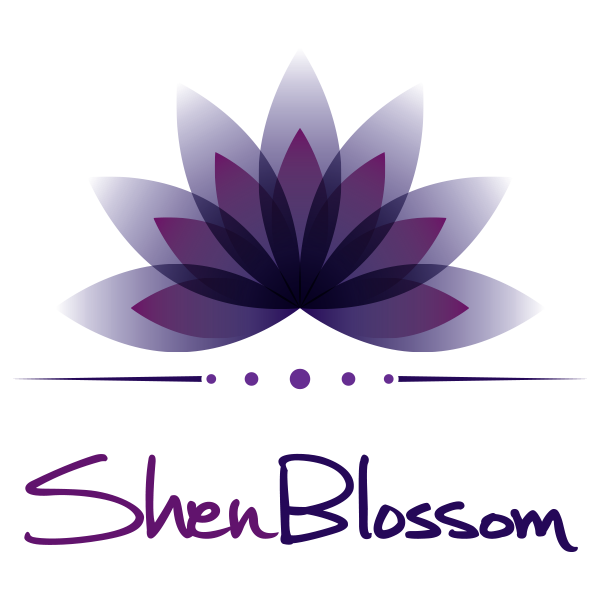
The Five Elements framework is an apparently simple, yet deeply complex in actuality, model designed to help us understand the foundational energetic properties, or forces/elements, that everything in nature unfolds from. While they are most commonly referred to as ‘elements’, many scholars argue that the term ‘phases’ is more appropriate, because the five elements are in a state of constant, dynamic change and interaction with each other, and are never static, stationary or sitting still.
The names of the five elements are wood, fire, earth, metal and water. Each of these five simple names that refer to an element of nature, also correspond energetically to their equivalents in all other aspects of nature and the universe, including: seasons, climate, tastes/flavors, the body’s organ systems and tissues, emotions, colors, vocalized sounds, stages of the cycle of cultivation/growth/harvest, and many more categories of natural phenomena.
The usefulness of the five element framework is mainly to cultivate a broad understanding of the effects of all natural phenomena on the state of the health and balance of our bodies and minds. It is used by TCM practitioners (and especially emphasized by the Japanese traditions) to diagnose imbalances and advise on appropriate foods, herbs and lifestyle changes that can restore balance and harmony to the body and mind. It is used by acupuncture practitioners to determine the most effective treatment strategies for a particular person’s health situation. It is even a basic principle in the popular Eastern practice of feng shui, various styles of martial arts, and also weaves its way into the ancient and highly influential texts of the I Ching (The Book of Changes).
There are many ways that an imbalance or sickness can show up, and each is a unique situation that requires a specific treatment approach to restore balance. In TCM, there is no “one size fits all” approach to health. For example, if someone is displaying symptoms of a cold, damp, and deficient nature, they will not get well by being advised to eat a raw food diet and live in a cold climate. Someone with signs of heat and excess will not get well eating rich, warm foods and living in a warm climate. This is why the dietary fads that Western people are so fond of have such drastically mixed results: depending on the state of one’s particular constitution, tendencies and vulnerabilities, one person’s panacea is another one’s undoing.
How The Five Elements Dynamically Interact
These “elements” are never at a standstill – their very nature is animate, since nature itself is constantly moving, and the five elements could be considered the foundational components of nature itself. Therefore, the real juice in the practical implementation of the five element theory relates to how each element dynamically interacts with the other elements. This is where the study of this framework starts to get deeper and more complex.
There are two main cycles of influence that describe how the elements interact with each other: the Generating cycle and the Controlling cycle. Each element generates, nurtures or feeds the next element in the order of the cycle. Fire burns down substance to create more earth, earth particles yield metals, metal in the form of rock slowly breaks down and adds minerals to water, water hydrates the plants that make wood, and wood catches on fire, which turns back into earth, and on and on. This is the generating cycle, and it corresponds to the order of the seasons: spring (wood), summer (fire), late summer (earth), fall (metal), and winter (water).
Most notably to our health, the generating cycle also describes which organ systems feed which other organ systems. That is important when we are dealing with excess or deficiency of a specific organ system, to determine the possible origin of the imbalance. Liver (wood) nourishes the heart (fire), the heart nourishes the spleen/stomach (earth), the spleen and stomach nourish the lungs (metal), the lungs nourish the kidneys (water), and the kidneys feed the liver (wood). One thing always leads to another. If one organ system is weak, the subsequent organ system will be undernourished, so based on this more complex and nuanced perspective of health, to strengthen a particular organ system, we would feed the organ that in turn feeds the organ showing signs of weakness. For example, if we are having lung trouble such as a chronic cough or shortness of breath, we may have to shift our focus to nourishing the spleen/stomach, which could then resolve the symptoms that are showing up in the lungs.
This gets even more complex when we factor in the controlling cycle. This tells us which elements exert control over which other elements, providing essential restrictions on their growth so that nothing will become excessive and end up consuming everything else. Seeing a diagram of this will make it easier to understand, because the controlling cycle jumps from one element not to the next one, but the one after that, essentially making the shape of a star. So earth controls water, water controls fire, fire controls metal, metal controls wood, and wood controls earth. When applied to the health of our organ systems, we can sense that if a specific organ system is displaying signs of excess, it may be that its controlling element is weak, and the excessive element is running unchecked and throwing off the balance of the whole body. As an example, since metal controls wood, if there are signs of liver (wood) heat/excess, it may be that the lung (metal) system is weak, and not exerting proper control over the liver system.
Additional informative nuances can be obtained by consulting the two sub-cycles of the controlling cycle, which are called the insulting cycle and the over-acting cycle. Over-acting is when any element is too strong (displaying excess), and “over acts” on the element it is supposed to balance and control, so ends up dominating it excessively and causing damage. Insulting is when any element is displaying excess, and turns back towards the element that is supposed to control it, wreaking havoc on its own normal control mechanism.
At this point, maybe you are getting an idea of how such a simple concept can become so complex, and be useful in so many applications related to healing and health maintenance!
Getting To Know The Five Elements
Now let’s get to know each of the five elements better! Even if you never have any need to apply the full complexities of this system we detailed above, just having a basic understanding of each element and its correspondences all across nature can help you apply it intuitively to your life.
The wood element is connected to the season of spring, a windy environment, the sour taste, the liver and gallbladder, the eyes, tendons, the emotion of anger and the vocal sound of shouting, and the color green. It is represented by the quick, new growth that happens in the spring. If the liver is stagnant from too much rich food and lack of physical activity over the winter, we can be prone to quick fits of anger. Sour and green foods can help cleanse the liver and bring us into physical and emotional balance. The new and rapid growth energy of spring can apply to our lives, but we need to ensure that we are neither stagnant nor excessive in our approach to life at this time.
The fire element is connected to the season of summer, a hot environment, the bitter taste, the heart and small intestine, the tongue, the emotion of joy and the sound of laughter, and the color red. Bitter foods nourish the physical heart, and encourage joyful and contended feelings. To balance the heat of the environment and to avoid overheating the heart, we eat cooling and hydrating foods, which can be the first fruits and vegetables that ripen in the heat of the summer, like melons and cucumbers.
The earth element is connected with late summer, or the seasonal transition between summer and fall. It is related to a damp environment, the sweet taste, the spleen and stomach, the mouth, muscles, the emotions of worry or pensiveness and the sound of singing, and the color yellow. Earth is the focus during this seasonal transition as we begin preparing for our earthly needs in the harsh season to come: harvesting crops, storing food for the winter, and fortifying ourselves nutritionally to withstand more easily the coming cold season. Much of the nourishing and building foods that are good to eat at this time have a predominantly sweet element, such as sweet fruits, corn, nuts, and winter squash.
The metal element is associated with fall/autumn, a dry environment, the pungent taste, the lungs and large intestine, nose, skin, hair, the emotion of grief and the sound of crying, and the color white. The fall season is about “falling”, or descending, into the cold and dark season to come. This can also be symbolized as grieving the inevitable losses in life. Healthy expression of grief can nourish and exercise the lungs, but grief that is either suppressed, or is excessive and doesn’t resolve, can constrict or exhaust the lung system. Pungent foods like ginger, garlic and onion nourish the respiratory system and encourage the qi to flow and process emotions in a healthy way.
The water element is associated with winter, a cold environment, the salty taste, the kidneys and bladder, ears, bones, the emotion of fear and the sound of groaning, and the color black. This time of the year is dark and still, and tells us to retreat deep within ourselves. The kidneys and bones contain our deepest energy reserves, our jing. Fear can show up in these dark times, and excessive fear can signal a deficiency or imbalance of the kidney system. Salty foods, which are rich in minerals, nourish our jing and therefore our kidneys and bones, and fortify our courage. It is a time to store up our energy reserves and charge up our batteries so we can be fully prepared for when spring finally comes, with its new and rapid growth and expansion of activity.
Conclusion
Even if we are not Traditional Chinese Medicine practitioners, it is tremendously helpful to every aspect of our lives to have an intuitive grasp of the five element framework. This can bring us insights related to health imbalances and how they relate to our food choices, the current season, our environment, and emotional difficulties we may be having. It can also help us in choosing foods and herbal formulas that will benefit us uniquely, instead of falling into the one-size-fits-all “diet trap” that many Westerners are prone to. The truth is that we need different things at different times, and even our basic constitution and genetic strengths and weaknesses can be dramatically different than another person’s.
We feel that the foundational TCM concepts of yin/yang and the five elements can help us get to know our own bodies and minds more intimately, and take charge of our health and lifestyle choices from a wiser and more knowledgeable perspective.

Thank you Brandon, I enjoy how your writing is easy to understand and very helpful. It’s nice to know how much of your perfection and attention go into your products so I can trust what I’m taking is the best and purest. Your work is deeply appreciated, and respected! Keep it up!…… and……THANK YOU!